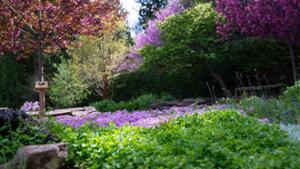Root Glen

In 1850, Oren Root bought the building (standing adjacent to the glen) which he named The Homestead. Oren and his wife, Nancy, set about planting trees, shrubs, and flowers in the cleared sheep pasture around their house.

By the time Oren’s son, Elihu, had inherited the property, the Roots had expanded the gardens. Although Elihu served his country as Secretary of War, Secretary of State and U.S. Senator, the Nobel Peace Prize winner and Hamilton College graduate found time to return to Clinton and supervise the care of the gardens and expansion of the tree plantings.
In 1937, Edward Root took over the gardening duties from his father. With his wife, Grace, he continued the development and added to the beauty of the glen. Edward was especially interested in hybridizing daffodils and iris; among his goals was producing a “true red” and a “true blue” in his iris hybrids.
After her husband’s death in 1956, Grace Root devoted even more of her time, resources, and enthusiasm to making the glen much as it is today. She established the Root Glen Foundation, the aims of which were to perpetuate the Glen as a place of beauty for public enjoyment, to use the land for appropriate educational purposes, to encourage programs that conserve rare and threatened plants, and to promote interest in the study of birds. In 1971, the Foundation was dissolved, and Grace transferred ownership of the Glen to Hamilton College, which administers the property according to the same principles that guided the Root family.

The glen contains some 65 species of trees, dozens of shrubs, and scores of varieties of flowers. Inside the Hemlock Enclosure, paralleling the hedge, are beds containing Tree Peonies hybridized by Professor A.P. Saunders, as well as iris, azaleas, lilies, and astilbes. There are numerous other perennials and annuals, some of which change each year as the glen evolves. Among the wooded areas, the Primrose Basin is noteworthy for its Candelabra primroses, a particular favorite of Grace Root. In the Asa Gray Bed are American pachysandra, Canadian moonseed vine, and lords-and-ladies, plants sent to Oren Root about 150 years ago by his friend, Dr. Gray, a professor of natural history at Harvard. A gift of ferns indigenous to Oneida County has been established along the Fern Path. The south side of the glen is a display of trees and plants native to the area.
The Root Glen is maintained by the horticultural grounds staff of the College.

Peonies
Professor of Chemistry A.P. Saunders hybridized the peonies in the early- to mid-1900s. His work with tree peonies — which resulted in 80 named varieties — was a notable achievement and his fame especially established with hybridizing the yellow tree peony. The Grant Garden, created by Elihu Root for his daughter, Edith Root, was renovated in 1996 to become a display garden for peonies.
Contact
Arboretum

